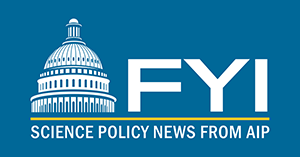Congress Seeks Compromise on Landmark Competitiveness Legislation
By Mitch Ambrose
This century’s biggest US science policy debate to date has reached a pivotal phase, with the House and Senate preparing to iron out differences between their distinct visions for expanding federal science agencies.
In June, the Senate passed the sprawling US Innovation and Competition Act (USICA), a 2,376-page legislative package that is primarily aimed at countering the Chinese government’s growing technological and geopolitical clout. The package includes the Endless Frontier Act, which would add a directorate to the National Science Foundation dedicated to advancing a periodically refreshed set of 10 “key technology focus areas.”

Through an at-times chaotic amendment process, the Senate assigned the Department of Energy and Defense Advanced Research Projects Agency a major role in supporting the same set of technology areas. It also added $52 billion for domestic semiconductor manufacturing incentives and R&D to implement the recently enacted CHIPS for America Act.
Rather than take up the USICA, the House passed the first pieces of its own legislative vision in June, starting with the NSF for the Future Act and the DOE Science for the Future Act. These and other bills will form the basis of negotiations with the Senate over a compromise package that will likely take months to complete.
The House Science Committee began developing the NSF bill soon after Senate Majority Leader Chuck Schumer (D-NY) first introduced the Endless Frontier Act last year with Sen. Todd Young (R-IN), unconvinced of the senators’ technology-centric vision for expanding the agency. Work on the DOE bill predates the Endless Frontier Act and reflects the committee’s longstanding interest in providing comprehensive policy direction to the DOE Office of Science.
The NSF for the Future Act would add a directorate to NSF focused on addressing a range of “societal challenges,” including ones not amenable to technological solutions or motivated by geopolitics. The bill also proposes Congress increase the annual budget of the new directorate to $3.4 billion over five years, whereas the Senate bill sets a target of nearly $10 billion.
A Democratic staff member for the committee told FYI the gap between the bills reflects “key philosophical differences.”
The staff member explained, “I still see the Senate approach as, ‘We have this gap in technology development. We don’t know how and where to fill it. We’re just going to use NSF as a vehicle.’ That is not the same as saying, ‘How can we leverage and build upon NSF strengths?’”
Committee leaders from both parties have said they believe it is possible to reach a compromise. The bills are not as far apart in their targets for NSF’s total annual budget, with the House proposing Congress increase it from the current level of $8.5 billion to $18 billion over five years while the Senate proposes $21 billion.
The House plans to push for DOE and the National Institute of Standards and Technology to be assigned a larger role in the final package. For instance, its DOE Science for the Future Act proposes Congress increase the Office of Science’s current annual budget of $7.0 billion by 60% over five years and includes detailed program-level guidance, whereas the USICA contains no policy direction for the office.
In any event, funding to reach such targets will have to be secured through future appropriations legislation. The exception is that the semiconductor funds in the USICA are structured as a mandatory appropriation, meaning no further legislative action would be required for them to be allocated. As of June, the House had not advanced a counterpart semiconductor proposal, though the funding could be added later or included in a final compromise bill.
The author is Director of FYI.
Published by the American Institute of Physics since 1989, FYI is a trusted source of science policy news that is read by congressional staff, federal agency heads, and leading figures in the scientific community. Sign up for free FYI emails at aip.org/fyi.
©1995 - 2024, AMERICAN PHYSICAL SOCIETY
APS encourages the redistribution of the materials included in this newspaper provided that attribution to the source is noted and the materials are not truncated or changed.
Editor: David Voss
Staff Science Writer: Leah Poffenberger
Contributing Correspondents: Sophia Chen, Alaina G. Levine
July/August 2021 (Volume 30, Number 7)
Articles in this Issue

